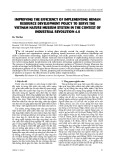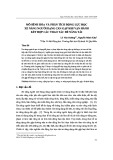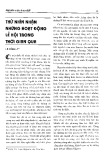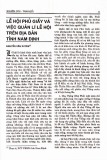
FTU Working Paper Series, Vol. 1 No. 2 (2/2022) | 223
ẢNH HƯỞNG CỦA KHOẢNG CÁCH VĂN HÓA LÊN HIỆU QUẢ HOẠT
ĐỘNG CỦA NHÂN VIÊN TẠI CÁC CÔNG TY ĐA QUỐC GIA
Phạm Hồ Nhất Phương1, Nguyễn Hoàng Anh, Phạm Thị Thanh Lan, Võ Anh Nhựt Minh,
Đinh Thị Thư
Sinh viên K57A - Quản trị kinh doanh quốc tế
Cơ sở II Trường Đại học Ngoại thương tại TP. Hồ Chí Minh, Việt Nam
Lê Sơn Đại
Giảng viên Bộ môn QTKD - TCKT
Cơ sở II Trường Đại học Ngoại thương tại TP. Hồ Chí Minh, Việt Nam
Tóm tắt
Nền kinh tế Việt Nam đang phát triển nhanh chóng và thu hút một lượng lớn sự quan tâm của các
nhà đầu tư nước ngoài. Tuy nhiên, hiệu quả lao động ở Việt Nam vẫn là một rào cản đối với các
nguồn vốn từ nước khác. Qua nghiên cứu của này, mối quan hệ tiêu cực giữa khoảng cách văn hóa
và hiệu quả làm việc của nhân viên tại các công ty đa quốc gia đã được chứng minh. Biến ngành
công nghiệp là một biến kiểm soát đối với hiệu quả làm việc của nhân viên. Đồng thời biến khoảng
cách thể chế điều tiết tiêu cực đối với mối quan hệ này. Từ kết quả nghiên cứu, các khuyến nghị
được đưa ra cho các công ty đa quốc gia bao gồm nên chú ý lựa chọn địa điểm để mở rộng quy mô,
nên ưu tiên những quốc gia có văn hóa tương đồng với công ty mẹ để giảm khoảng cách văn hóa.
Bên cạnh đó, nhà quản lý có thể giảm bớt tác động của khoảng cách văn hóa bằng việc lựa chọn
phương thức thâm nhập phù hợp, các phương thức thâm nhập ít sự kiểm soát và ít rủi ro thấp như
cấp phép, liên doanh, hay mua lại và sáp nhập sẽ phù hợp hơn khi tham gia vào các thị trường có
khoảng cách văn hóa cao.
Từ khóa: Công ty đa quốc gia, kinh doanh quốc tế, hiệu quả hoạt động, nhân viên
IMPACTS OF CULTURAL DISTANCE ON
PERFORMANCE OF EMPLOYEES IN MNCs’ SUBSIDIARIES
Abstract
Performance of employees is described as the “ultimate dependent variable” in human resource
management, enhancing it is the priority of corporations to create long-term competitive
advantages. Furthermore, recent literature stated that cultural distance is an important determinant
of employee performance. This paper aims to clarify the impacts of the cultural distance between
home and host country on the performance of employees in multinational corporations’
subsidiaries in Vietnamese market. This study also investigates the moderation effect of career
1Tác giả liên hệ, Email: phnp2304@gmail.com
Working Paper 2022.1.2.16
- Vol 1, No 2

FTU Working Paper Series, Vol. 1 No. 2 (2/2022) | 224
experience and institutional distance on the mentioned relationship. Our results support the
hypothesis that cultural distance has a significant negative impact on employee performance and
this relationship is affected by the industry sector. In addition, the relationship is also moderated
by experience and institutional distance. These findings will contribute in helping MNCs improve
their employee performance by mitigating the impact of cultural distance through choosing a
suitable country and entrance modes to expand.
Keywords: Cultural distance, employee performance, MNCs, institutional distance
1. Introduction
Culture has long been proven as a barrier to the internationalization process of multinational
corporations (MNCs) in the world (Beugelsdijk, 2018). Companies have to deal with several
critical decisions such as entry modes (Tihanyi et al., 2005), international diversification (Grosse
and Trevino, 1996), subsidiary management (Roth and O’Donnell, 1996), and human resources
management (Morosini et al., 1998). Failure to understand elements surrounding the subsidiary
national culture would lead to an adaptation crisis (De Mooij & Hofstede, 2010). In addition, in
order to evaluate the efficiency of a subsidiary, performance of employees is among the most
essential aspects when operating business (Brayfield & Crockett, 1955). As a result, more and
more scholars have been drawn attention to the relationship between employee performance and
cultural distance (Shenkar, 2001; Froese & Peltokorpi, 2011; Ahammad et al., 2016).
Additionally, in previous studies, the main concern of the authors was the relationship
between cultural distance and job performance (Morosini, 1998; Froese & Peltokorpi, 2011).
However, the effects of control and moderate variables have not been mentioned (Dikova & Sahib,
2013; Shahzadi et al., 2014; Meyerson & Dewettinck, 2012) in these researches. Therefore, this
research aims to observe these variables: whether they have an effect on the relationship and how
the impact is as well as whether there are other factors moderating this relationship such as
industrial, direct manager's nationality, etc. Because there are studies only mention a relationship
but not take into account the external environment, including many factors that can moderate this
relationship, which results in impurity in research (Chen et al., 2010). If the result supports our
hypothesis, it will be an important contribution for MNCs in Vietnam to find solutions to optimize
employee’s productivity.
To bridge the mentioned gaps above, this research aims to discover the direct relationship
between cultural distance and performance of employees on subsidiaries of multinational
corporations. Consequently, this paper gives a firm positive statement on the relation between the
two variables. Finally, based on the results, MNCs can take into account the suggested implications
when expanding to other territories.
This study uses the standard framework of Perry (1998) which has 5 sections widely applied
in academic literature. In detail, section 1 identifies the elements that make the topic worth
researching and deliver contexts as well as rationale for the research. Section 2 provides review of
current literature on the contexts: Employee performance and cultural distance. From that, a
theoretical model with hypotheses was proposed to bridge the gaps of those literatures. It is
followed by section 3 which justifies the methodology and the data analysis process used to
examine the proposed theoretical model. A report of the results is presented and key findings are
also highlighted in section 4. Eventually, section 5 consists of the conclusion with a brief summary

FTU Working Paper Series, Vol. 1 No. 2 (2/2022) | 225
of the paper. It also proposes implications for MNCs when expanding to other countries and
discusses limitations as well as suggestions for further research.
2. Literature review
Kogut and Singh are the firsts to lay the foundation of cultural distance when they mention
the differences in entry modes because of the influence of culture factors (Kogut and Singh, 1988).
It was described to be the extent to which the cultural norms in one country have a significant
difference when compared to another country (Kogut and Signh, 1988). Using Hofstede’s
multidimensional culture framework, Kogut and Singh (1988) introduced a Euclidean distance
measure to capture cross-country cultural differences in one index. The Euclidean distance index
takes the difference on the national score on each of Hofstede’s cultural dimensions (Hofstede,
1980) and then aggregates these differences in one overall index. Cultural distance is calculated as
the distance to a single country. The vast majority of cultural-distance studies follow this approach
in operationalizing and measuring cultural distance (Kirkman et al., 2006; Kirkman, Lowe, &
Gibson, 2017).
Culture governs the way of thinking and the soul of humans (Hofstede, 2010). Hofstede
identified six major dimensions to explain differences among cultures. These are: (1) Power
distance; (2) Individualism and collectivism; (3) Masculinity; (4) Uncertainty avoidance; (5)
Long-term orientation; (6) Indulgence.
Employee performance is the process of an individual using his/her own skills, experience,
knowledge, personality and abilities (Vroom, 1964; Hunter, 1986) with a view to reach their goals.
In other words, Azar & Shafighi (2013) described that job performance is a set of behavioural and
functional patterns involving knowledge, skills, managerial competence, conscience and cognitive
abilities in the work environment - the same words of Rothmann et al. in 2002. Employee
performance has been also described by Motowidlo (2003) as the overall values accumulated by
an individual during a specified period of time as discrete pieces of behaviours expected by the
organization. Employee’s performance is the combining of quality and quantity of the work or
task that employees executed to fulfill a specific target (Shahzadi et al, 2014).
The final strand examines the influence of cultural distance on subsidiary
performance. Accordingly, the major studies indicate that due to the complexity and uncertainty
of doing business in a distant host country, cultural distance is expected to have a negative effect
on employee performance. This perspective is proved through the studies of Maseland et al. 2018;
Beugelsdijk et al. 2018; Brouthers, Marshall & Keig, 2016; Harzing & Pudelko, 2016; van Hoorn
& Maseland, 2016). In addition, there are a number of factors studied that have an impact on
employee performance and are influenced by cultural distance as well, such as organizational
culture (Kawiana, et.al., 2018; Szydło & Grześ-Bukłaho, J., 2020), cross-cultural training
(Shahzadi et al., 2014; Kempf, & Holtbrügge, 2020), interests and reward management system
(Lent et al., 1994; Sullivan & Hansen, 2004; Mehmood et. al., 2013) and so on.
Based on previous literature, this research predicts a negative relationship between cultural
distance and employee performance in MNCs. With the different approaches mentioned above and
with gap not being studied, we hypothesize that:
H1: Cultural distance between home-host countries has a significant negative impact on
employee performance of MNCs’ subsidiaries.

FTU Working Paper Series, Vol. 1 No. 2 (2/2022) | 226
There is a large number of studies on employee age and performance, and they seemed to fail
to identify a clear relationship between them. While some research showed a positive relationship
between the performance of employees and their age, the others showed a negative one (Ng and
Feldman, 2008). Waldman and Avolio (1986), in their meta-analysis with 40 samples in 13
empirical studies, found that age has a positive impact on employee performance at productivity
measures but a negative impact on employee performance at supervisor ratings. Thus, we also
consider age is one control variable and it is necessary to delete its impacts from employee
performance.
According to Wang and Giouvris (2020), each different industry has its own characteristics.
And foreign firms belonging to different industries (manufacturing vs non-manufacturing) are
differently affected by cultural distance and country risk (Wang and Giouvris, 2020). Specifically,
according to Drogendijk and Slangen (2006), the impact of cultural distance and country risk on
manufacturing companies is less than non-manufacturing companies. Through this, we come to a
conclusion that each industry has its own characteristics and this affects the impact of the
independent variables (in this paper, cultural distance).
A number researchers suggest explanations for these findings that women have more
sensitiveness and interests in developing relationships with colleagues than their man counterparts
(Major and Adams, 1983; Major et al., 1984; Rosener, 1990) or men have a higher level of
participation and performance along with the competitiveness than women do (Croson and
Gneezy, 2009). These gender differences in abilities, skills, style of work, orientation, participation
make each gender employee performance different (Croson and Gneezy, 2009), so that we
consider it is also one control variables which we need to remove to purify the relationship between
to our independent variables (cultural distance) and employees performance
For the above reasons, the hypothesises are formulated:
H2: The relationship between cultural distance and MNCs employee performance is
significantly controlled by industry.
H3: The relationship between cultural distance and MNCs employee performance is
significantly controlled by gender.
H4: The relationship between cultural distance and MNCs employee performance is
significantly controlled by age.
Several theories have laid the foundation of perception about the relationship between job
experience and performance. If employees can exploit themselves in experience, they can improve
their ability, and in progress influence employees’ job performance (employee performance)
(Ehrenberg & Smith, 2000). Employee experience is also predicted to be able to enhance
performance of employees (Weiss & Bloom, 1990). Both opinions have the same idea that
employee performance changes overtime because individuals accumulate job experience.
In this paper, we will only mention the first aspect of institutional distance, scholars have
argued that focussing on all three pillars of institutional distance rather provides a broad basis for
analysis, thus leading to oversimplification (Zaheer et al., 2012). Differences in the regulative
pillar of institution between the home and host countries have influence on how economic actors
interact (North, 1990). One of the cultural orientations that helps explain a key difference between
the United States and Germany, for example, is the attitude towards uncertainty. In Hofstede’s

FTU Working Paper Series, Vol. 1 No. 2 (2/2022) | 227
study (1980) Germany has an uncertainty avoidance index of 67, whereas the United States has an
uncertainty avoidance index of 43. That means Americans are more comfortable with uncertainty
than Germans such as they will have fewer laws in comparison with Germans wanting certainty
and protection from risk. Hence, we hypothesize:
H5: Job experience significantly negatively moderates the relationship between culture
distance and employee performance.
H6: Institutional distance significantly negatively moderates the relationship between culture
distance and employee performance.
Figure 1. Conceptual model
Source: Authors
3. Methodology
To measure the employee performance, this research uses surveys as the main source to collect
primary data from employees of MNCs’ subsidiaries in Viet Nam. Two parts are included in the
instrument survey. Section A covers the demographic of both the respondent and the company
where he/she works. The objective of this part was to collect the control variables data and
demographic information. Section B is a range of criteria to assess employee performance
(employee performance), these criteria are based on the past literature. There are 6 criteria with
sub-criteria written in statements. These statements will be graded through a 5-point Likert scale.
These points in the scale are “Strongly Disagree” (1), “Disagree” (2), “Uncertain” (3), “Agree”
(4), “Strongly Agree” (5).
Table 3. Sources of questionnaire
No.
Items
Content
References
EP1
Task evaluation
I was able to schedule my job so that it
was finished on time.
I adequately performed all the tasks
assigned
I carried out duties that are required of
me
Kiker &
Motowidlo, 1999


























